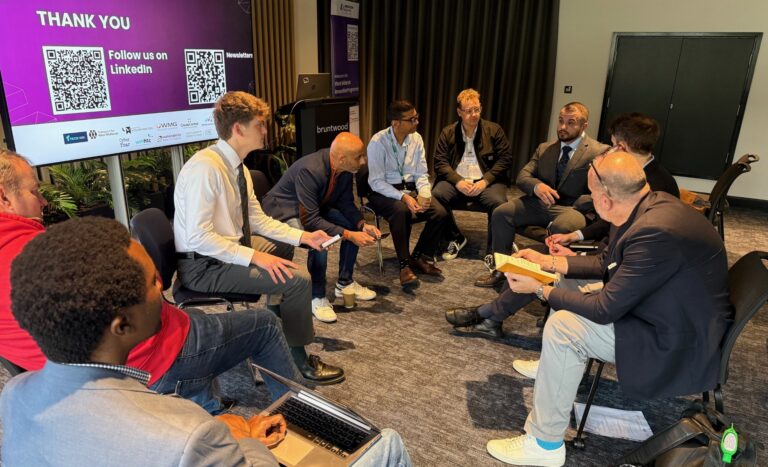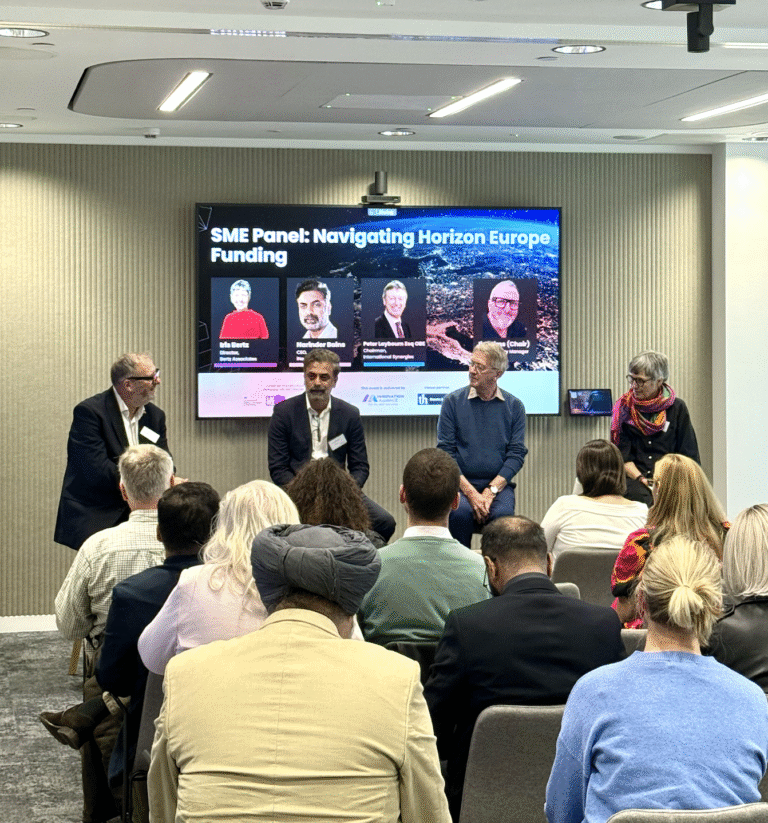Innovation Economy Perspectives from Amanda Brooks, Director of Innovation at BIS
The Birmingham Science City Chief Technology Officers Group’s May event was hosted at Birmingham Research Park. We were delighted to welcome Amanda Brooks, Director of Innovation, at the Department of Business, Innovation and Skills (BIS). Amanda presented on the role of her department and, in particular, her ambition for it to maximize its proactive stance in response to the opportunities and challenges present within both innovation and economic ecosystems.
Adopting an open, discursive and dialogue-rich approach towards CTO members, Amanda nurtured lively debate and conversation. This enabled both attendees and Amanda herself to come away with much food for thought with which to shape collaborative local, national and pan-European approaches to increasing innovation in science and technology capabilities- all whilst achieving wealth creation.
Amanda shared that she had learned from experience that success in developing and attaining the joint goals of innovation and economic prosperity come down to listening and co-operating whilst leading. For her CTO audience, this translates as a call to members- in their senior leadership capacities- to respond to existing networks and relationships in science, technology and business, and so create the best ‘climate for connectivity’. For Amanda, this is also key to her department’s effectiveness and the measure by which she feels it will thrive or fail to make itself worthy of the ‘Innovation’ in its title. To make this leadership approach work properly, she noted some ingredients necessary for turning this connectivity maxim from simply looking good on paper into creating tangible results. These are: accessibility, investment, internationalization and scalability.
Accessibility
Capturing real results for the UK means making innovation and wealth-creation opportunities easily accessible to businesses. This starts with ensuring that innovation policies are right for us, as a UK economy, and making certain that the structures and tools through which these policies operate allow businesses of all sizes a clear and accessible route to opportunity. A priority for Amanda and her department is supporting the Technology Strategy Board and encouraging its evolution in a way that makes accessibility central to what it does.
Investment
Creating accessibility is only part-way down to policy, structures and tools, says Amanda. At the end of the day, progressing in the right direction means committing investment and, more specifically, investment in the right places- sectorally and geographically throughout the UK. As she explains, our historical legacy has not given us too much of a head-start: ‘The UK industrial structure has a distorted pattern in terms of where our research and development spending is going… National research and development proportions of public and private spend are low in comparison to other countries’. But we can make this paradigm shift happen from here on in. No easy task, granted; but a necessary one, for certain. (We may note that these views, reassuringly, answer some of the questions and observations from our last blog on balancing national excellence and local need.)
Putting forward a request to the audience, Amanda asked attendees to help the government understand why it is important to invest more in science, technology and innovation. Her ‘ask’ was not for just a one-off consultation, but a call for regular dialogue, to which the CTO group responded enthusiastically.
Internationalisation
Prior to her current position, Amanda spent a number of years in the Far East. She played a crucial role in creating growth policies and industrial strategies, in Singapore, as the UK’s Deputy High Commissioner. The experience, she explained, has made a lasting impression on her and is shaping her approach towards what she does today. Fundamental to her views on innovation for economic growth is the reliance of this growth on international collaboration- connecting the dots between local, national and international environments, and not treating their dynamics as separate and unrelated. This means encouraging trade and industry relationships, but it is also about adopting and adapting to new ways of working. All of these points were met with considerable approval by the audience and formed the basis for constructive discussions throughout the morning.
Some of the insightful and useful points made by CTO members comprised the following:
- Science parks are great centres with which to bring together localized innovation networks, strengths and energies. We can use them to connect to wider national and international dynamics.
- European Structural and Investment Funds (ESIF) provide an excellent way to lever not only finances but common goals and priorities from sub-national to international levels. (The audience articulated strongly the need to create and pursue ways of using local and national funds to leverage ESIF, especially those funds from the Local Economic Partnerships and from the Technology Strategy Board.)
- Our respective organisations, and the ecosystems that we create between us need to be co-ordinated and must work towards the right kind of outputs and objectives. We can look to the international stage for examples of how to do this effectively.
Coming out of the internationalization discussion arose exchanges around scalability.
Scalability
The group was keen to understand how, given the disappearance of regional- level governance, a coordinated innovation offering could be made by and in partnership with the 39 Local Economic Partnerships. Members found this a challenging prospect, particularly as LEP boundaries do not necessarily overlap with natural innovation and economic boundaries, in geographical terms. Amanda acknowledged the limitations, expressing desire for BIS to facilitate support for LEPs to ensure that they do work with these natural boundaries. (Although she noted two significant realities. One- not being able to change the current LEP boundaries and their inherent limitations; and, two- the more fundamental issue of vulnerabilities inherent in changing political administrations and the operational shifts caused by their respective ways of working.)
Amanda explained that the TSB could help by linking in with the regions, but that this will most likely be in the form of embedding their activities within and with existing environments and organisations, rather than setting up new regional hubs of their own.
Other crucial ingredients of effective scalability identified were: the creation of well-coordinated business support mechanisms; effective procurement channels; and training, knowledge-sharing and up-skilling for businesses in order for them to make the most of opportunities for themselves. So, first, we must foster the creation of business support products with particularly strong co-ordination of both their control mechanisms and content. (This will avoid the proliferation of near-duplicate initiatives and individual projects, and the confusion and resource inefficiencies that would ensue). Second, there must be recognition that there is a necessarily steep learning curve for public sector organisations to climb, to share good practice in providing a critical mass of procurement routes and means that are realistic for the most innovative businesses (be they large or small). Lastly, there should be greater promotion of schemes such as Horizon 2020- already with a high UK uptake, but which can be promoted even further- where businesses and, of late most especially SMEs, can lead research and development projects designed specifically to further their own innovation potential and market competitiveness- ideas to wealth in a nutshell.
Amanda posed two questions to the audience:
- What is working well with BIS’ approach and what needs to be improved? (Where are the successes? Where are the gaps? Where should we spend or not spend? What and where is the evidence for our responses to these questions?)
- What does the interaction with local, national and European landscapes look like for your organisations and partnerships? How can we make things clearer and easier to access and work with?
What are your views? Do let us know and help us to keep the dialogue with Amanda and BIS very much open and alive.
Amanda can be followed on Twitter: @AmandaBrooksBIS
The Chief Technology Officers Group provides a forum for science and technology innovation leads from larger private and public sector organisations to network, share ideas, increase best practice and discover business opportunities. If you and/or your organisation would like to find out more, please go to: http://www.birminghamsciencecity.co.uk/about-us/business-groups/cto-group
Our thanks to Dr James Wilkie, CEO of Birmingham Research Park Ltd, and his team for hosting the event.
Susannah Goh, Demonstrator Development Manager, Birmingham Science City





